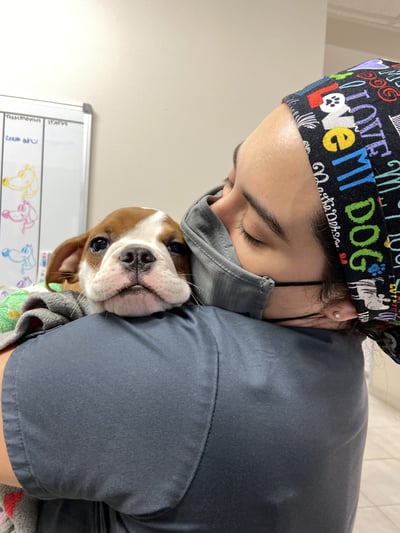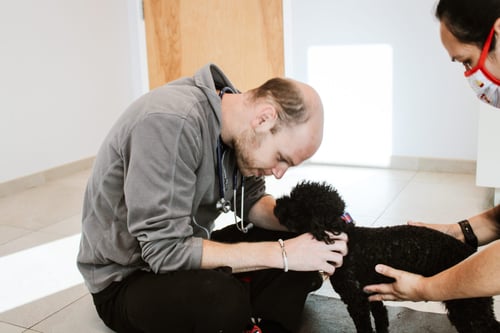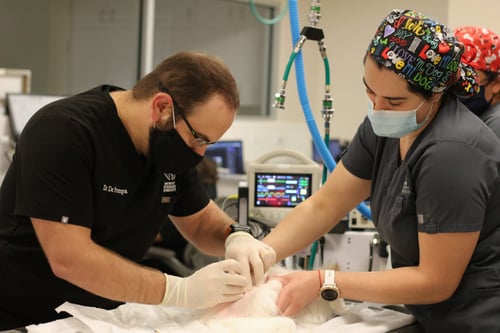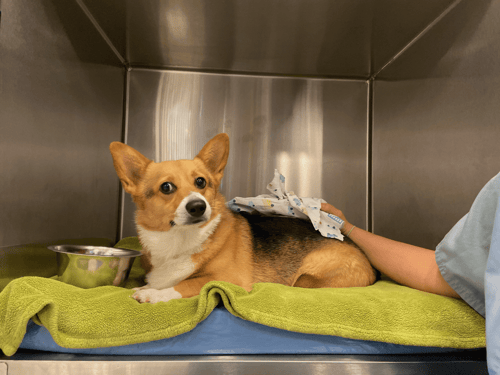Dog Anesthesia: When Is It Needed and Is It Safe?
Anesthesia is a drug-induced, temporary loss of awareness and sensation used for medical purposes. Under dog anesthesia, a patient’s consciousness is controlled so that:
- Your dog cannot move
- Your dog cannot feel pain
- Your dog is unaware of what is going on
- Your dog is unable to remember the experience
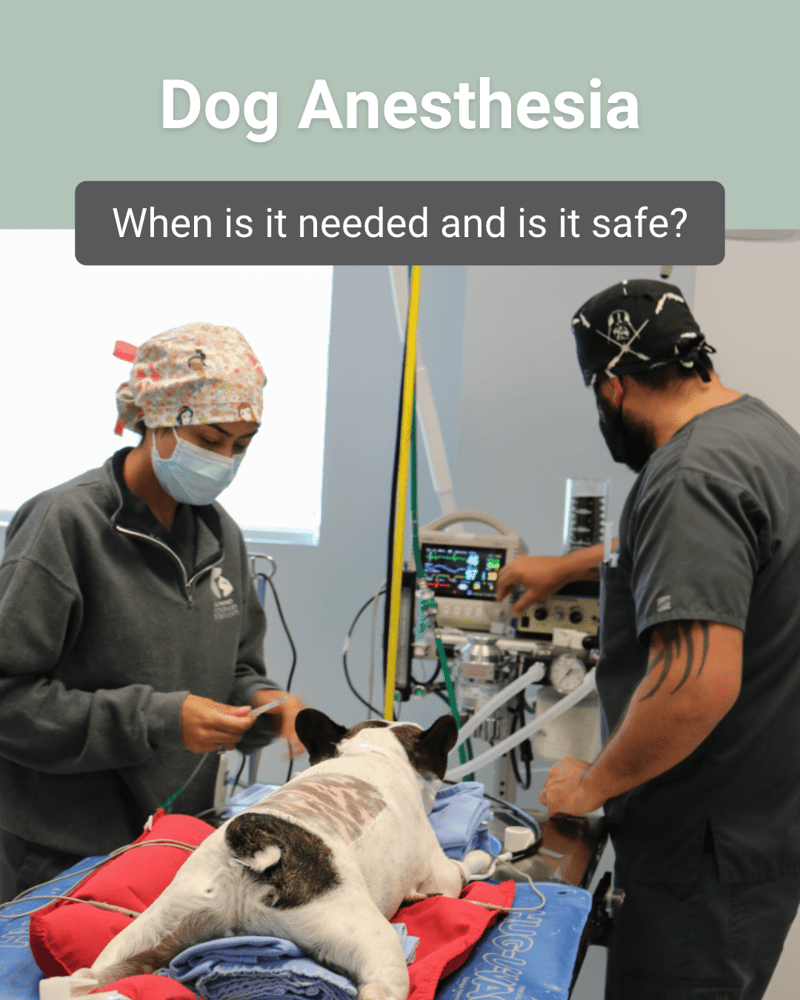
When is Dog Anesthesia Necessary?
Just like in humans, dog anesthesia is used during surgeries and invasive medical procedures. However, many noninvasive procedures that can be done while humans are awake cannot be performed accurately on alert dogs. Generally, any procedure that requires a dog to stay perfectly still for a significant period of time requires anesthesia.
At Southeast Veterinary Neurology (SEVN), anesthesia is routinely used for procedures other than surgery, such as magnetic resonance imaging (MRI) to visualize the brain and spinal cord.
“Anesthesia is necessary for advanced imaging diagnostics to keep the patient nice and steady in order for us to obtain various high-quality images for our neurologists to examine,” explains Anaily Gonzalez, Certified Veterinary Technician and Imaging and Surgery Department Lead at Southeast Veterinary Neurology.
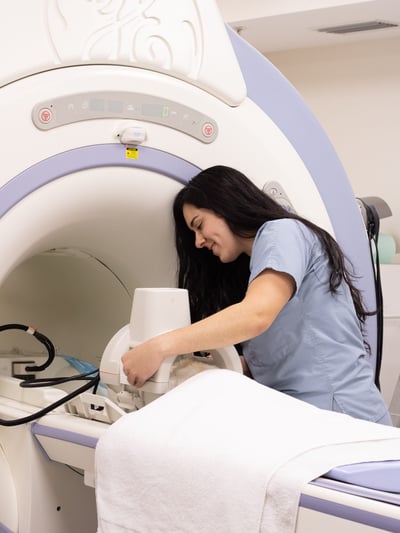
Is Dog Anesthesia Safe?
Like any medical procedure, anesthesia carries risks. However, deaths related to dog anesthesia are highly unusual. As research and technology have developed, dog anesthesia has become much safer than it was several years ago, which is where any stigma today still comes from. In fact, according to the 2020 American Animal Hospital Association Anesthesia Guidelines for Dogs and Cats, the risk of death from anesthesia in a healthy dog is less than 0.05%.
When it comes to safety, the veterinary staff’s knowledge and training combined with how the patient is monitored and supported are what can make the difference. As a modern veterinary hospital, SEVN works with the most up-to-date and sophisticated guidelines, drugs, and monitoring systems available in order to minimize risk. Our highly-trained team reduces that risk even further.
How are Risks of Dog Anesthesia Minimized?
Safe dog anesthesia relies on knowledgeable drug choices and the precise monitoring and support of patients before, during, and after the procedure.
“At SEVN, anesthetic protocols not only depend on the type of procedure being done, but are also tailored to the patient. The patient’s age, breed, size, history, and health status are all key factors in the selection of the anesthetic protocol,” Anaily says.
BEFORE ANESTHESIA
Many complications of anesthesia can be anticipated and prepared for. A big part of why the risk of death from dog anesthesia is so low is that veterinarians thoroughly screen patients for potential risks beforehand.
Anaily elaborates, “At SEVN, prior to undergoing anesthesia, the neurologist will review your dog’s medical history, perform both physical and neurological exams, obtain bloodwork, and take chest X-rays to ensure your dog is healthy enough to tolerate the anesthetic procedure.”
After careful consideration, the neurologist will choose an anesthetic protocol and determine if any specific interventions might reduce risk for your dog.
DURING ANESTHESIA
SEVN’s anesthetic protocol begins with IV catheter placement, through which pre-medications are administered to ease any anxiety, pain, or discomfort that your dog may experience.
“Following the induction process, your dog is provided with general anesthesia in the form of a gas inhalant that is absorbed through the respiratory system. Anesthesia is only administered by highly-trained veterinary technicians from SEVN’s Imaging and Surgery Team, under supervision of the doctor on the case,” Anaily explains.
The most common complications of dog anesthesia include low blood pressure, decreased heart rate and respiratory rate, and low body temperature. At SEVN, precautions include immediate access to the respiratory and cardiovascular systems along with multiparameter monitors to ensure the patient’s vitals remain within normal limits.
During anesthesia, SEVN’s multiparameter monitors keep track of:
- Oxygenation levels
- Heart rate
- Respiratory rate
- Temperature
- Levels of exhaled carbon dioxide
- ECG waves
- Blood pressure
However, the most valuable monitor during anesthesia is a specially-trained veterinary technician.
“While a SEVN technician is monitoring your dog during anesthesia, that is their one and only responsibility. This technician is solely focused on patient monitoring to ensure that your dog remains stable throughout the procedure,” Anaily points out.
AFTER ANESTHESIA
The American Animal Hospital Association reports that almost half of anesthetic-related deaths occur during the first few hours of the post procedure period. Therefore, it is critical that patients recovering from dog anesthesia are also monitored by trained personnel.
At SEVN, your dog is transferred to the Intensive Care Unit (ICU) to recover after anesthetic procedures. Our skilled ICU team of experts keeps patients warm, comfortable, and under close observation until they return to normal consciousness. During this time, a dedicated veterinary technician is continuously monitoring the same vital signs that are monitored while under anesthesia.
Anaily emphasizes, “While a SEVN technician is monitoring your dog during recovery, their one and only responsibility until your dog fully recovers is to ensure that all vitals are within normal limits.”
SPECIAL CONSIDERATIONS
Many of the dogs we treat are brachycephalic, such as French Bulldogs, Pugs, English Bulldogs, Boston Terriers, Shih Tzus, Cavalier King Charles, and Brussels Griffons. Brachycephalic dogs are bred to have a relatively broad, short skull, resulting in the flattened face look so many pet parents can’t get enough of.
“The anatomy of their shortened noses can result in difficulty breathing,” notes Anaily. “At SEVN, brachycephalic breeds are given supplemental flow-by oxygen longer than the other breeds we typically work with in preparation for anesthesia. While recovering from anesthesia in the ICU, they will continue to be provided with 100% oxygen until they become more alert.”
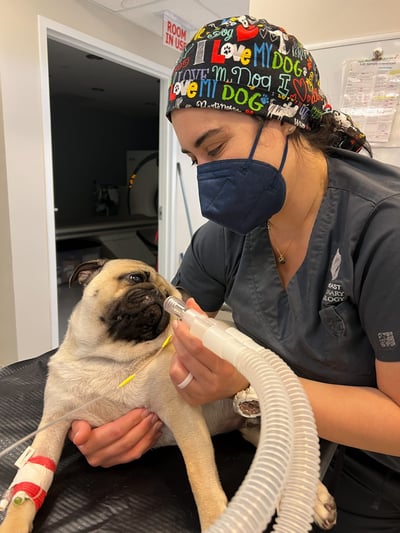
Still Worried about Dog Anesthesia?
Even though the vast majority of patients do absolutely fine with dog anesthesia, it’s perfectly understandable for you to be concerned. After all, low risk does not mean no risk. If you’re worried, speak openly with your veterinarian about how anesthesia can affect your dog, what safety protocols are in place, and how your pet will be monitored and cared for before, during, and after the procedure. A vet would never recommend something that is going to hurt your dog.
Southeast Veterinary Neurology is the largest veterinary neurology practice in the state of Florida, with a new location in Virginia Beach. Because we exclusively treat neurological conditions, we perform advanced imaging studies and complex procedures every day. Therefore, our team of experts is highly knowledgeable, well trained, and thoroughly experienced in anesthesia.
Should you have questions about the use of dog anesthesia in your pup’s upcoming procedure, contact one of our locations in Miami, Boynton Beach, Jupiter, or Virginia Beach!
